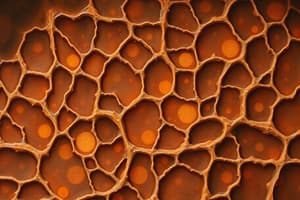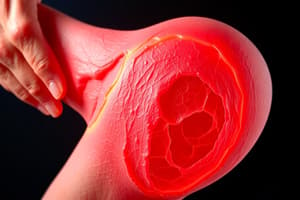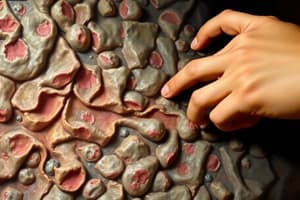Podcast
Questions and Answers
Which of the following is a characteristic of healing by second intention, compared to healing by first intention?
Which of the following is a characteristic of healing by second intention, compared to healing by first intention?
- More intense inflammatory reaction (correct)
- Reduced inflammatory response
- Minimal granulation tissue formation
- Smaller clot formation
In secondary intention healing, what is the primary role of myofibroblasts?
In secondary intention healing, what is the primary role of myofibroblasts?
- Inhibiting the formation of granulation tissue
- Promoting rapid epithelialization across the wound surface
- Facilitating wound contraction to reduce the size of the defect (correct)
- Secreting large amounts of collagen to form a dense scar
Which component is predominantly found in the initial clot or scab formed during secondary intention healing?
Which component is predominantly found in the initial clot or scab formed during secondary intention healing?
- Keratin and melanin
- Collagen and elastin
- Fibrin and fibronectin (correct)
- Hyaluronic acid and proteoglycans
Why do larger tissue defects have a greater potential for inflammation-mediated injury during secondary intention healing?
Why do larger tissue defects have a greater potential for inflammation-mediated injury during secondary intention healing?
What is the typical outcome regarding scar tissue formation in secondary intention healing compared to primary intention healing?
What is the typical outcome regarding scar tissue formation in secondary intention healing compared to primary intention healing?
How do G protein-coupled receptors (GPCRs) typically influence growth factor-related pathways?
How do G protein-coupled receptors (GPCRs) typically influence growth factor-related pathways?
Which of the following is a characteristic of growth factor receptors that lack intrinsic kinase activity?
Which of the following is a characteristic of growth factor receptors that lack intrinsic kinase activity?
What is the role of the extracellular matrix (ECM) in tissue repair?
What is the role of the extracellular matrix (ECM) in tissue repair?
What happens if the ECM is damaged during tissue repair?
What happens if the ECM is damaged during tissue repair?
Which of these represents a function of the ECM?
Which of these represents a function of the ECM?
How do proteoglycans in the ECM influence cell proliferation and differentiation?
How do proteoglycans in the ECM influence cell proliferation and differentiation?
What is the role of fibronectin and laminin in stimulating cells within the ECM?
What is the role of fibronectin and laminin in stimulating cells within the ECM?
What role does the extracellular matrix play in maintaining tissue structure and function?
What role does the extracellular matrix play in maintaining tissue structure and function?
What is the primary distinction between tissue regeneration and scar formation in tissue repair?
What is the primary distinction between tissue regeneration and scar formation in tissue repair?
Which factor directly influences the ability of tissues to repair themselves?
Which factor directly influences the ability of tissues to repair themselves?
What are Induced Pluripotent Stem Cells (iPS) derived from?
What are Induced Pluripotent Stem Cells (iPS) derived from?
What is a major function of growth factors in tissue repair?
What is a major function of growth factors in tissue repair?
What activity is intrinsic to Receptor Tyrosine Kinases (RTKs)?
What activity is intrinsic to Receptor Tyrosine Kinases (RTKs)?
Which of the following best describes autophosphorylation of Receptor Tyrosine Kinases (RTKs)?
Which of the following best describes autophosphorylation of Receptor Tyrosine Kinases (RTKs)?
Which cells commonly produce growth factors involved in tissue repair?
Which cells commonly produce growth factors involved in tissue repair?
What is the potential consequence of mutations in proto-oncogenes, which are influenced by growth factors?
What is the potential consequence of mutations in proto-oncogenes, which are influenced by growth factors?
Scar formation occurs when tissue injury is:
Scar formation occurs when tissue injury is:
Which factor, if deficient, would most significantly inhibit collagen synthesis and retard wound healing?
Which factor, if deficient, would most significantly inhibit collagen synthesis and retard wound healing?
How do glucocorticoids affect scar formation?
How do glucocorticoids affect scar formation?
In the first week after injury during cutaneous wound healing by first intention, what cellular event occurs around day 3?
In the first week after injury during cutaneous wound healing by first intention, what cellular event occurs around day 3?
What is the primary characteristic of the scar at the end of the first month of healing by first intention?
What is the primary characteristic of the scar at the end of the first month of healing by first intention?
Following an injury, which event would most likely lead to healing via scar formation rather than complete tissue restoration?
Following an injury, which event would most likely lead to healing via scar formation rather than complete tissue restoration?
Which of the following factors would least likely impair the healing process of a cutaneous wound?
Which of the following factors would least likely impair the healing process of a cutaneous wound?
What is the predominant event during the second week of cutaneous wound healing by first intention?
What is the predominant event during the second week of cutaneous wound healing by first intention?
Flashcards
Wound Healing
Wound Healing
The process by which the body repairs damaged tissue after an injury.
Tissue Repair Types
Tissue Repair Types
Two main types: regeneration of injured tissue and scar formation via connective tissue.
Cell Proliferation
Cell Proliferation
The process of cell growth and division, essential for tissue regeneration.
Growth Factors
Growth Factors
Proteins that regulate cell survival, proliferation, and differentiation during tissue repair.
Signup and view all the flashcards
Induced Pluripotent Stem Cells (iPS)
Induced Pluripotent Stem Cells (iPS)
Mature cells reprogrammed to behave like stem cells, capable of differentiating into various cell types.
Signup and view all the flashcards
Receptor Tyrosine Kinases (RTKs)
Receptor Tyrosine Kinases (RTKs)
A class of cell surface receptors with intrinsic kinase activity that phosphorylates tyrosine residues.
Signup and view all the flashcards
Angiogenesis
Angiogenesis
The formation of new blood vessels from existing ones, a critical process during healing.
Signup and view all the flashcards
Scar Formation
Scar Formation
The process of fibrous tissue deposition that replaces normal tissue after injury.
Signup and view all the flashcards
Healing by Second Intention
Healing by Second Intention
A complex healing process for large wounds involving regeneration and scarring.
Signup and view all the flashcards
Granulation Tissue
Granulation Tissue
New connective tissue and tiny blood vessels that form during healing.
Signup and view all the flashcards
Myofibroblasts
Myofibroblasts
Cells that aid in wound contraction, acting like muscle cells.
Signup and view all the flashcards
Wound Contraction
Wound Contraction
The process of a wound shrinking in size, mainly due to myofibroblasts.
Signup and view all the flashcards
Secondary Wound Healing
Secondary Wound Healing
Healing process involving a larger clot and intense inflammation due to extensive tissue loss.
Signup and view all the flashcards
G Protein-Coupled Receptors (GPCRs)
G Protein-Coupled Receptors (GPCRs)
Cell surface receptors that transmit signals through G proteins.
Signup and view all the flashcards
Intrinsic Kinase Activity
Intrinsic Kinase Activity
The ability of some receptors to directly perform phosphorylation.
Signup and view all the flashcards
Transforming Growth Factor-beta (TGF-β) Receptor
Transforming Growth Factor-beta (TGF-β) Receptor
A receptor that recruits non-receptor kinases for signaling.
Signup and view all the flashcards
Extracellular Matrix (ECM)
Extracellular Matrix (ECM)
A network of proteins surrounding cells, aiding in tissue structure and repair.
Signup and view all the flashcards
ECM Remodeling
ECM Remodeling
The ongoing process of ECM synthesis and degradation.
Signup and view all the flashcards
Mechanical Support of ECM
Mechanical Support of ECM
Collagen and elastin provide structural integrity to tissues.
Signup and view all the flashcards
Substrate for Cell Growth
Substrate for Cell Growth
ECM serves as a surface for cells to attach and proliferate.
Signup and view all the flashcards
Role of Fibronectin and Laminin
Role of Fibronectin and Laminin
These proteins stimulate cells via integrin receptors.
Signup and view all the flashcards
Factors Influencing Wound Healing
Factors Influencing Wound Healing
Elements that can affect the rate and success of healing, like infection or nutrition.
Signup and view all the flashcards
Infection and Healing
Infection and Healing
Infection can delay the healing process and prolong inflammation due to immune response.
Signup and view all the flashcards
Nutrition's Role in Healing
Nutrition's Role in Healing
Deficiencies in protein and Vitamin C can inhibit collagen synthesis and slow healing.
Signup and view all the flashcards
Glucocorticoids Effect
Glucocorticoids Effect
These can weaken scars by inhibiting growth factors; however, they may help with corneal infections.
Signup and view all the flashcards
Mechanical Variables
Mechanical Variables
Physical factors like pressure that can impair the healing process.
Signup and view all the flashcards
Healing by First Intention
Healing by First Intention
A type of wound healing characterized by minimal tissue loss and rapid repair.
Signup and view all the flashcards
Timeline of First Intention Healing
Timeline of First Intention Healing
Healing progresses over weeks: inflammation, granulation, and scar formation occur in stages.
Signup and view all the flashcards
Keloid Formation
Keloid Formation
An aberration of cell growth leading to excessive scar tissue development beyond the original injury site.
Signup and view all the flashcardsStudy Notes
Wound Healing and Tissue Repair
- Wound healing involves two main reactions: regeneration of injured tissue and scar formation by connective tissue deposition.
- Lecture objectives include describing cell and tissue regeneration, the repair process using connective tissue, angiogenesis and scar formation, and the mechanism of cutaneous wound healing.
Tissue Repair
- Tissue repair occurs through two main reactions: regeneration of the injured tissue and scar formation via connective tissue deposition.
- Tissue repair reactions vary based on injury severity. Mild injury demonstrates regeneration, while severe injury exhibits scar formation.
Cell and Tissue Regeneration
- Injured cell and tissue regeneration involves cell proliferation driven by growth factors. The process is greatly dependent on the integrity of the extracellular matrix.
- This process includes proliferation, differentiation and the role of stem cells.
Proliferative Capacities of Tissues
- Tissues are categorized as labile, stable, or permanent based on their ability to regenerate.
- Labile cells continuously divide (bone marrow, certain epithelium, skin).
- Stable cells are quiescent but can divide (liver, kidney, fibroblasts).
- Permanent cells do not divide (neurons, cardiac myocytes).
Stem Cells (Embryonic and Adult)
- Embryonic stem cells are pluripotent, capable of differentiating into any cell type.
- Adult stem cells are multipotent, able to differentiate into a limited range of cell types. Different types of adult stem cells exist (neural, mesenchymal, hematopoietic, muscle stem cells, epidermal/hair follicle).
- Induced pluripotent stem cells (iPS) are derived from mature cells by introducing genes from embryonic stem cells.
Growth Factors
- Growth factors are mostly proteins that stimulate cell survival, proliferation, migration, differentiation, angiogenesis, and fibrogenesis.
- Growth factors are crucial for repair processes, stimulating the function of growth control genes.
- Many growth factors involved in repair are produced by macrophages and lymphocytes, or parenchymal/stromal cells in response to injury. Specific examples given in a table.
Growth Factor Signaling
- Growth factor signaling can be categorized based on receptor types with or without intrinsic kinase activity.
- Receptor Tyrosine Kinases (RTKs) have intrinsic kinase activity, phosphorylating tyrosine residues to activate signaling pathways. Examples include EGFR and insulin receptor.
- G-Protein-Coupled Receptors (GPCRs) activate intracellular signaling pathways through G-proteins and indirectly influence pathways like cAMP, IP3. Examples include epinephrine and chemokine receptors.
- Some receptors (e.g., TGF-β receptor) lack kinase activity, relying on associated kinases for signaling.
Role of the Extracellular Matrix (ECM) in Tissue Repair
- The ECM is a complex protein network surrounding cells, providing structural support, turgor pressure, and a reservoir for growth factors.
- ECM is comprised of interstitial matrix and basement membrane, each with distinct components like collagen, fibronectin, elastin, proteoglycans, and hyaluronate.
- ECM regulates cell proliferation, movement, and differentiation, and plays a role in tissue regeneration and repair.
- ECM is constantly undergoing synthesis and degradation, which is critical in morphogenesis, wound healing, chronic fibrosis, and tumor invasion.
Important Functions of ECM
- Provides mechanical support
- Acts as a substrate
- Regulates cell proliferation and differentiation
- Allows regeneration if intact
- Supports repair with scar formation if damaged
Scar Formation
- Tissues can be repaired by regeneration (complete) or replacement with connective tissue (scar).
- Scar formation occurs when tissue injury is severe, prolonged, or damages parenchymal, epithelial, and connective tissue causing non-dividing cell harm.
- It involves angiogenesis, fibroblast migration and proliferation, collagen synthesis, and connective tissue remodeling that culminates in granulation tissue formation. Multiple growth factors are essential for scar formation.
Steps in Scar Formation
- A series of steps leads to scar formation: inflammation, formation of new blood vessels, formation of granulation tissues (migration of fibroblasts + deposition of connective tissues, interspersed leukocytes), and scar formation (maturation and reorganization of fibrous tissue).
Factors Influencing Wound Healing
- Infection, nutrition, mechanical factors (perfusion, type and extent of injury), and cell growth abnormalities (keloids) affect wound healing.
Clinical Examples of Tissue Repair (Cutaneous wound healing, Fibrosis)
- Cutaneous wound healing exemplifies the principles of tissue repair, involving epithelial regeneration and connective tissue scar formation.
- Healing follows different pathways (first and second intention) dependent on injury severity.
Healing by First Intention
- Healing by first intention describes rapid wound healing with minimal tissue loss, primarily epithelial regeneration and formation of a thin scar. It involves a series of cellular events including neutrophil migration, epithelial cell proliferation, macrophage activity and neovascularization.
Healing by Second Intention
- Healing by secondary intention involves a greater degree of tissue loss and the formation of prominent, thick scar tissue, requiring extensive ECM deposition, wound contraction from myofibroblasts. It is a more complex and prolonged repair process than healing by first intention.
Differences between Primary and Secondary Healing
- Differences in clot formation, inflammation intensity, granulation tissue volume, scar tissue mass, and wound contraction distinguish secondary from primary healing.
Studying That Suits You
Use AI to generate personalized quizzes and flashcards to suit your learning preferences.




